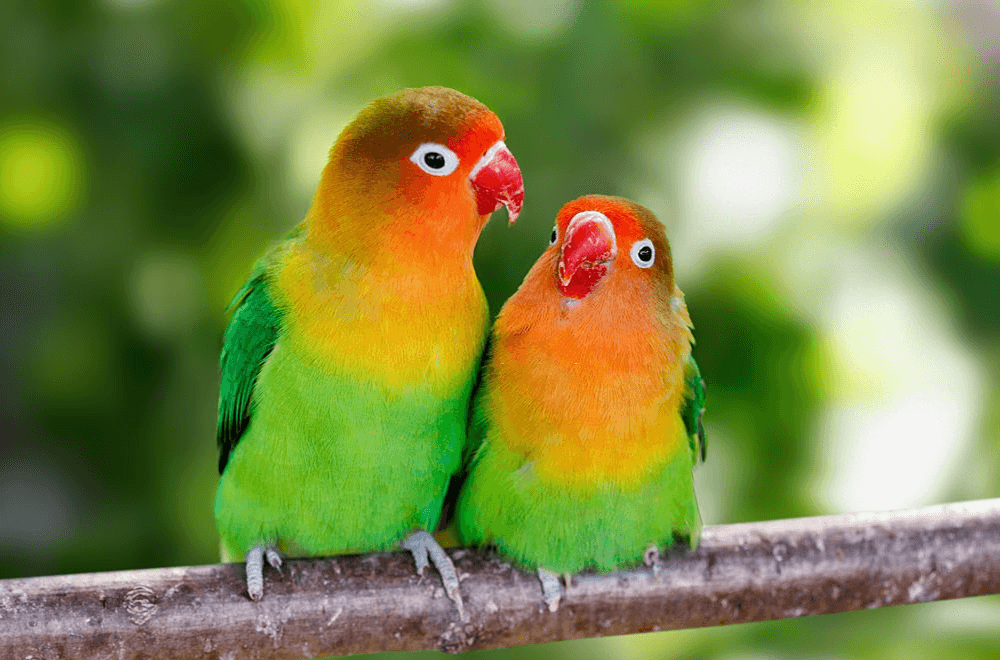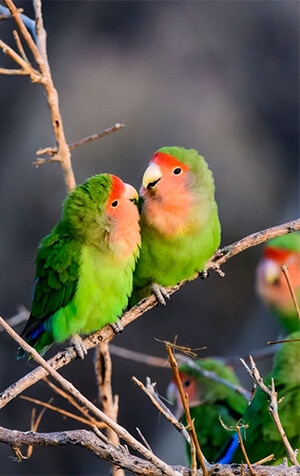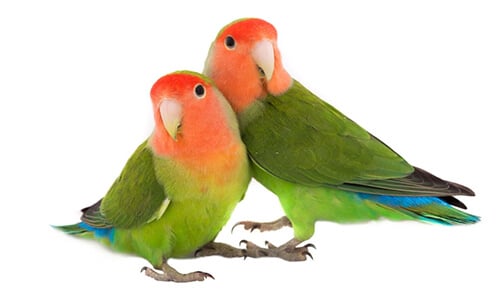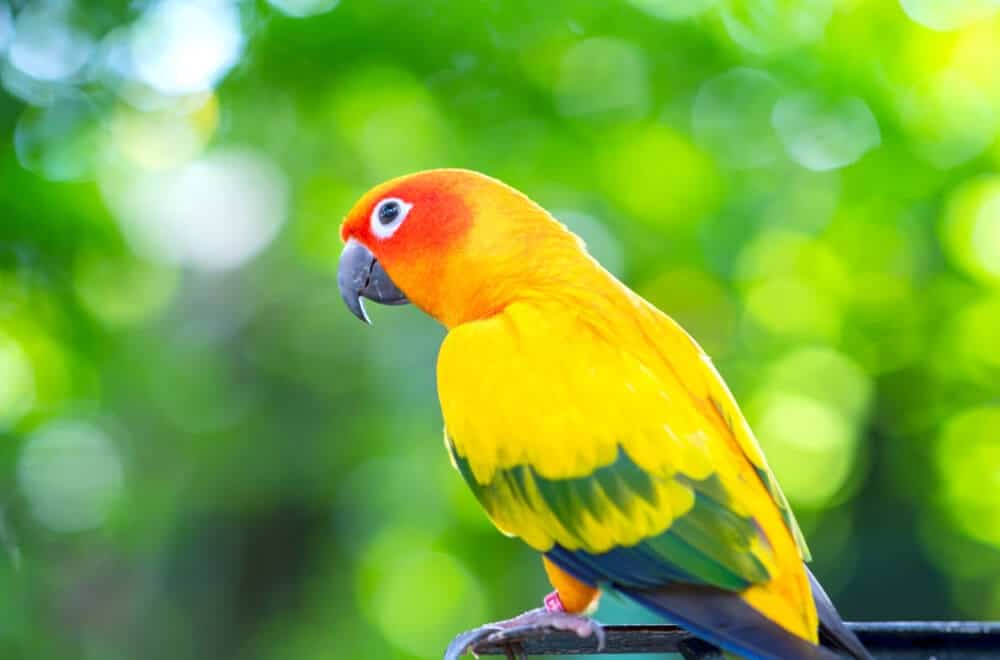The lovebird parrot (Agapornis), also known as the pocket parrot, is a small and colorful bird that lives in the African continent. They are considered to be one of the smallest species in the parrot family.
Lovebird parrots are given this name because of their strong monogamous pair bond and love they show for each other.
The Agapornis genus is derived from 2 Greek words. ‘Agape’ stands for love and ‘Ornis’ means bird.
Savannas and forests of Madagascar and Africa are the favorite places for these parrots. They have usually observed feeding and flying in small groups and are rarely found in large flocks.
Scientific classification
- Scientific Name: Agapornis
- Kingdom: Animalia
- Phylum: Chordata
- Class: Aves
- Order: Psittaciformes
- Family: Psittaculidae
- Subfamily: Agapornithinae
- Genus: Agapornis
Characteristics and features:
- Common names: yellow-collared lovebird, Lilian lovebird, black-winged lovebird, pocket parrot
- Color: the love birds are mostly found in green, orange, blue, and yellow colors.
- Size and Weight: A lovebird parrot is found approximately from 13 – 17 cm (5 – 7 in) in length, having 40 – 60 g (1.5 – 2 oz) weight.
- Lifespan: average lifespan is 20 – 30 years.
- Sound: These parrots do not produce high noise but they are good whistlers and can make little chattering sound.
Different species of the lovebird parrots
Yellow–Collared lovebird (Agapornis personatus)
The yellow–collared lovebird, also known as a masked lovebird, is native to Tanzania. These birds usually exhibit yellow and green color with a blue tail. The masked lovebirds are 14 cm (5.5 in) in length.
Lilian’s lovebird (Agapornis lilianae)
The lilian lovebird, also known as nyasa lovebird, is the resident of Malawi. These birds have a green color with the red beak, orange head, and white circles around the eyes. They are 13 cm (5 in) in length.
Fischer’s lovebird (Agapornis fischeri)
The Fischer lovebird is a beautiful parrot that lives in northern Tanzania. They are 14 cm (5.5 in) in size and are mostly found in green color with a blue lower back, orange head, red beak, and white spot around the eyes.
Black–cheeked lovebird (Agapornis nigrigenis
The black–cheeked lovebird is a bird that is found largely in Zambia. They exhibit green color with reddish-brown forecrown and forehead, brown throat, orange chest, and red beak. They have the same size as that of a yellow and fischer lovebird.
Peach–faced lovebird (Agapornis roseicollis)

Black–winged lovebird (Agapornis taranta)
The black–winged lovebird, also known as Abyssinian lovebird, is a bird that lives in Ethiopia. The males usually have a green color with a red mark on the face, while females are completely green. They are 16.5 cm (6.5 in) in length.
Red–headed lovebird (Agapornis pullarius)
The red–headed lovebird, also known as red–faced lovebird, is mostly found in central Africa. They are green in color with red head and face. They are 15 cm (6 in) in size.
Grey–headed lovebird (Agapornis canus)
The grey–headed lovebird, also known as Madagascar lovebird, is a bird that lives in Madagascar. They are 13 cm (5 in) in length and are usually seen in green color with a grey head, neck, and upper body.
Black–collared lovebird (Agapornis swindernianus)
The black–collared lovebird, also known as Swindern lovebird, is native to equatorial Africa. These parrots exhibit green color with a black margin at the back of the neck, grey beak, and brown collar. These parrots are 13.5 cm (5 in) in size.
Nutrition and diet
Like to any other parrots, a proper and healthy nutrition is important. Below, a few of the foods that these little birds enjoys to eat::
- Vegetables (squash, cooked potatoes, carrots, broccoli, zucchini)
- Fruits (apples, mangoes, papaya, grapes, etc)
- Dark leafy greens (chicory, turnip, romaine, dandelion leaves, and collard greens)
- Berries, seeds
Behavior and personality

These birds normally do not interact much with the people, and if you take a pair of lovebirds in your house, they will be more focused on each other rather than on you.
Proper housing needs
The lovebirds should be provided with a proper sized cage to allow them comfortably live without any problems. The minimum dimensions for the accommodation of one bird should be 1m x 1m x 1m. Besides this, they can be provided with toys or other stuff to entertain them.
They should be allowed to make flights out of the cage for some specific time in a day that makes them fresh and healthy.
Quick information about the breeding of lovebirds
These birds prefer to make nests on the trees and the female bird gathers all necessary material to be placed in the nests before breeding.
Baby lovebird parrot
Baby lovebirds takes between 21 and 23 days to come out of the egg after the female lay. These baby birds are usually observed to be fed by the female lovebird.
The female bird takes food in her beak, crushes it and then feed to his little chick. The parent lovebirds look after their baby lovebirds until they start to take care of their needs.
Common health problems
The lovebird parrot may suffer from various health problems if they are not given enough care and healthy food. One of the most common problems that lovebirds can face is Malnutrition. It occurs due to the deficiency of calcium and vitamin A in the body.
This disease mostly appears in the parrots who take seeds in more quantity because seeds are high in fats. It can be cured by giving fresh fruits and vegetables to parrots. Besides this, they can also suffer from self- mutilation, chlamydiosis, etc.
For a healthy parrot, you should visit a veterinary from time to time, to ensure that your little bird is healthy.
- Breeding Season: August to January (may vary for some species)
- Clutch Size: 4 – 6 eggs
- Incubation time: About 23 days
- Time in the nest: 30 days
Common questions & answers
Are lovebirds good pets?
Yes, lovebirds can be your good pets but sometimes they may be more aggressive than the parakeets. Many people love to keep this small parrot in their houses because of their size and attractive personality.
Do lovebirds bite?
Usually, they don’t bite for some ordinary reason but like people, if they get frustrated or angry due to some doing, they may bite you. It depends upon your behavior with them, some owners rarely get a bite but some may get it multiple times a day.
Bird Names Ideas for Lovebirds
Choosing the perfect name for your beloved lovebirds can be a fun and creative endeavor. Here are some delightful bird names that perfectly match the charm and personality of these small parrots:
- Sunny & Sky: A cheerful pair of names that capture the vibrant colors and playful nature of lovebirds.
- Luna & Sol: These names reflect the beauty and brightness of the moon and sun, just like your lovebirds’ presence.
- Mango & Kiwi: Fruity and fun, these names bring a touch of tropical sweetness to your feathered friends.
- Pepper & Mint: A spicy and refreshing combination that mirrors the lively character of lovebirds.
- Buddy & Belle: Classic and endearing, these names symbolize the close bond shared by lovebird pairs.
- Coco & Latte: These names capture the warm, earthy tones often found in lovebird plumage.
- Echo & Harmony: Reflecting their chattering nature, these names evoke a sense of togetherness and melody.
- Ruby & Emerald: Precious gem names that mirror the dazzling and vibrant colors of lovebirds.
- Peanut & Jelly: A playful and whimsical choice that highlights the delightful contrast of your feathered duo.
- Tango & Salsa: Energetic and lively, these names capture the rhythmic movements of your lovebirds.
Remember, the most important thing is to choose names that resonate with you and your lovebirds’ unique personalities. Whether you go for something sweet, quirky, or meaningful, the perfect name will add an extra layer of love and connection to your cherished pets.
How much doe lovebirds Cost?
You can buy a lovebird for around 150 USD. The price may vary for different species depending upon their location or physical appearance.
Did you enjoy reading this article? Meet the little chubby bird, the rock parrot.
In the end, if you want to have these little cute companions, you should have knowledge of a proper diet and housing conditions. Having a pair of these little parrots is always better than a single one.

